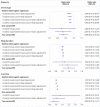Investigating causal relations between sleep traits and risk of breast cancer in women: mendelian randomisation study
- PMID: 31243001
- PMCID: PMC6592406
- DOI: 10.1136/bmj.l2327
Investigating causal relations between sleep traits and risk of breast cancer in women: mendelian randomisation study
Abstract
Objective: To examine whether sleep traits have a causal effect on risk of breast cancer.
Design: Mendelian randomisation study.
Setting: UK Biobank prospective cohort study and Breast Cancer Association Consortium (BCAC) case-control genome-wide association study.
Participants: 156 848 women in the multivariable regression and one sample mendelian randomisation (MR) analysis in UK Biobank (7784 with a breast cancer diagnosis) and 122 977 breast cancer cases and 105 974 controls from BCAC in the two sample MR analysis.
Exposures: Self reported chronotype (morning or evening preference), insomnia symptoms, and sleep duration in multivariable regression, and genetic variants robustly associated with these sleep traits.
Main outcome measure: Breast cancer diagnosis.
Results: In multivariable regression analysis using UK Biobank data on breast cancer incidence, morning preference was inversely associated with breast cancer (hazard ratio 0.95, 95% confidence interval 0.93 to 0.98 per category increase), whereas there was little evidence for an association between sleep duration and insomnia symptoms. Using 341 single nucleotide polymorphisms (SNPs) associated with chronotype, 91 SNPs associated with sleep duration, and 57 SNPs associated with insomnia symptoms, one sample MR analysis in UK Biobank provided some supportive evidence for a protective effect of morning preference on breast cancer risk (0.85, 0.70, 1.03 per category increase) but imprecise estimates for sleep duration and insomnia symptoms. Two sample MR using data from BCAC supported findings for a protective effect of morning preference (inverse variance weighted odds ratio 0.88, 95% confidence interval 0.82 to 0.93 per category increase) and adverse effect of increased sleep duration (1.19, 1.02 to 1.39 per hour increase) on breast cancer risk (both oestrogen receptor positive and oestrogen receptor negative), whereas evidence for insomnia symptoms was inconsistent. Results were largely robust to sensitivity analyses accounting for horizontal pleiotropy.
Conclusions: Findings showed consistent evidence for a protective effect of morning preference and suggestive evidence for an adverse effect of increased sleep duration on breast cancer risk.
Published by the BMJ Publishing Group Limited. For permission to use (where not already granted under a licence) please go to http://group.bmj.com/group/rights-licensing/permissions.
Conflict of interest statement
Competing interests: All authors have completed the ICMJE uniform disclosure form at http://www.icmje.org/coi_disclosure.pdf. MKR reports receiving research funding from Novo Nordisk, consultancy fees from Novo Nordisk and Roche Diabetes Care, and modest owning of shares in GlaxoSmithKline, outside the submitted work. DAL reports receiving research support from Medtronic and Roche Diagnostics for research outside the submitted work. All other authors declare no support from any organisation for the submitted work, no financial relationships with any organisations that might have an interest in the submitted work in the previous three years, no other relationships or activities that could appear to have influenced the submitted work.
Figures

References
MeSH terms
Grants and funding
- MC_UU_00011/2/MRC_/Medical Research Council/United Kingdom
- 19169/CRUK_/Cancer Research UK/United Kingdom
- MC_QA137853/MRC_/Medical Research Council/United Kingdom
- MR/P012167/1/MRC_/Medical Research Council/United Kingdom
- MC_UU_00011/7/MRC_/Medical Research Council/United Kingdom
- MC_UU_00011/1/MRC_/Medical Research Council/United Kingdom
- MR/M005070/1/MRC_/Medical Research Council/United Kingdom
- MC_UU_00011/6/MRC_/Medical Research Council/United Kingdom
- MR/P014437/1/MRC_/Medical Research Council/United Kingdom
- 001/WHO_/World Health Organization/International
- MC_UU_00011/5/MRC_/Medical Research Council/United Kingdom
- MC_PC_17228/MRC_/Medical Research Council/United Kingdom
LinkOut - more resources
Full Text Sources
Medical
